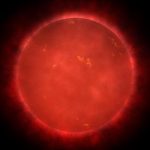Podcast: Play in new window | Download
Subscribe: RSS

Artist illustration of a red dwarf star.
We think we live near an average star, but that’s not the case at all. Compared to most stars in the Universe, the Sun is a giant! Let’s look at the small end of the stellar spectrum, to stars with a fraction of the size and mass of our own Sun. There are many ways that a star can get small, and they lead dramatically different lives and deaths.
|
|
Show Notes
- How big (or little) is our Sun? Sun’s Mass: 1.9891 ×1030 KG
- A red dwarf is a small, cool, very faint, main sequence star whose surface temperature is under about 4,000 K. Red dwarfs are the most common type of star. Proxima Centauri is a red dwarf. (via Enchanted Learning)
- Red Dwarf Stars –– Universe Today
- Red Dwarf Stars — Wiki
- How long do stars last? — Universe Today
- Paper: Habitability of Planets Around Red Dwarf Stars — University of Texas
- Gliese 581 — Wiki
- Hydrogen Burning — Cornell
- Brown Dwarf Stars — Cool Cosmos
- Research on Brown Dwarfs — UC Berkeley
- Red Dwarf Stars — Universe Today
- Red Dwarfs — Wiki
- Electron Degeneracy Pressure — Wolfram
- White Dwarf –– GSU
- White Dwarf — Goddard SFC
- Background radiation of the Universe (CMB) — UBC
- Black dwarf stars — Universe Today
- Black dwarfs — Wiki
- How are black dwarf stars and neutron stars similar? Goddard SFC
- Blue stragglers in globular clusters — SolStation
- Looking for Planets Around White Dwarf Stars –– Professor Astronomy
- Ep. 86 End of Everything Pt. 1
- Ep. 87 End of Everything Pt. 2
